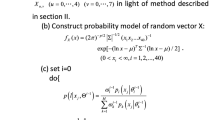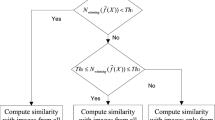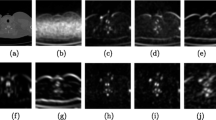Abstract
Multiple Classifier System has found its applications in many areas such as handwriting recognition, speaker recognition, medical diagnosis, fingerprint recognition, personal identification and others. However, there have been rare attempts to develop content-based image retrieval (CBIR) system that uses multiple classifiers to learn visual similarity. Texture as a primitive visual content is often used in many important applications (viz. Medical image analysis and medical CBIR system). In this paper, a texture image retrieval system is developed that learns the visual similarity in terms of class membership using multiple classifiers. The way proposed approach combines the decisions of multiple classifiers to obtain final class memberships of query for each of the output classes is also a novel concept. A modified distance that is weighted with the membership values obtained through similarity learning is used for ranking. Three different algorithms are proposed for the retrieval of images against a query image displaying the strength of multiple classifier approach, class membership score and their interplay to achieve the objective defined in terms of simplicity, retrieval effectiveness and speed. The proposed methods based on multiple classifiers achieve higher retrieval accuracy with lower standard deviation compared to all the competing methods irrespective of the texture database and feature set used. The multiple classifier retrieval schemes proposed here is tested for texture image retrieval. However, these can be used for any other challenging retrieval problems.






Similar content being viewed by others
References
Atrey PK, Hossain MA, El Saddik A, Kankanhalli MS (2010) Multimodal fusion for multimedia analysis: a survey. Multimedia Systems 16(6):345–379
Brodatz P (1966) Textures: a photographic album for artists and designers, vol 66. Dover New York
Carkacioglu A, Vural F-Y (2002) Learning similarity space. In: Proceedings of 2002 international conference on image processing. 2002, vol 1. IEEE, pp I–405
Chechik G, Sharma V, Shalit U, Bengio S (2010) Large scale online learning of image similarity through ranking. J Mach Learn Res 11(Mar):1109–1135
Dash JK, Mukhopadhyay S, Garg MK, Prabhakar N, Khandelwal N (2014) Multi-classifier framework for lung tissue classification. In: Students’ technology symposium (TechSym), 2014 IEEE. IEEE, pp 264–269
Dash JK, Mukhopadhyay S, Gupta RD (2015) Content-based image retrieval using fuzzy class membership and rules based on classifier confidence. IET Image Process 9(9):836–848
Dash JK, Mukhopadhyay S, Gupta RD (2016) Multiple classifier system using classification confidence for texture classification. Multimedia Tools Appl 1–22
Dash JK, Mukhopadhyay S, Prabhakar N, Garg M, Khandelwal N (2013) Content-based image retrieval for interstitial lung diseases using classification confidence. In: SPIE medical imaging. International Society for Optics and Photonics, pp 86702Y–86702Y
Dubey SR, Singh SK, Singh RK (2015) Local diagonal extrema pattern: a new and efficient feature descriptor for ct image retrieval. IEEE Signal Process Lett 22 (9):1215–1219
Duda RO, Hart PE, Stork DG (2012) Pattern classification. Wiley
Farrell KR (1995) Text-dependent speaker verification using data fusion. In: International conference on acoustics, speech, and signal processing, 1995. ICASSP-95, 1995, vol 1. IEEE, pp 349–352
Farrell KR, Ramachandran RP, Sharma M, Mammone RJ (1997) Sub-word speaker verification using data fusion methods. In: Proceedings of the 1997 IEEE workshop neural networks for signal processing [1997] VII. IEEE, pp 531–540
Felipe JC, Traina AJM, Traina C (2003) Retrieval by content of medical images using texture for tissue identification. In: Proceedings of 16th IEEE symposium computer-based medical systems, 2003. IEEE, pp 175–180
Glatard T, Montagnat J, Magnin IE (2004) Texture based medical image indexing and retrieval: application to cardiac imaging. In: Proceedings of the 6th ACM SIGMM international workshop on Multimedia information retrieval. ACM, pp 135–142
Guo G, Li SZ, Chan KL (2000) Learning similarity for texture image retrieval. Comput Vis-ECCV 2000:178–190
Han J, Ma K-K (2007) Rotation-invariant and scale-invariant gabor features for texture image retrieval. Image Vis Comput 25(9):1474–1481
Huenupán F, Yoma Nestor B, Molina C, Garretón C (2008) Confidence based multiple classifier fusion in speaker verification. Pattern Recogn Lett 29(7):957–966
Jain AK, Ross A, Prabhakar S (2004) An introduction to biometric recognition. IEEE Trans Circuits Syst Video Technol 14(1):4–20
Kittler J, Hatef M, Duin RPW, Matas J (1998) On combining classifiers. IEEE Trans Pattern Anal Mach Intell 20(3):226–239
Kolmogorov AN (1963) On the representation of continuous functions of many variables by superposition of continuous functions of one variable and addition. Amer Math Soc Transl 28:55–59
Kozat SS, Venkatesan R, Mihçak MK (2004) Robust perceptual image hashing via matrix invariants. In: International conference on image processing, 2004. ICIP’04. 2004, vol 5. IEEE, pp 3443– 3446
Kuncheva LI (2004) Combining pattern classifiers: methods and algorithms. Wiley
Kuncheva LI, Whitaker CJ (2003) Measures of diversity in classifier ensembles and their relationship with the ensemble accuracy. Mach Learn 51(2):181–207
Lam L (2000) Classifier combinations: implementations and theoretical issues. In: Multiple classifier systems. Springer, pp 77–86
Lee KH (2006) First course on fuzzy theory and applications, vol 27. Springer
Lei X, Krzyzak A, Suen CY (1992) Methods of combining multiple classifiers and their applications to handwriting recognition. IEEE Trans Syst Man Cybern 22 (3):418–435
Ma W-Y, Manjunath BS (1996) Texture features and learning similarity. In: IEEE computer society conference on computer vision and pattern recognition, 1996. Proceedings CVPR’96, 1996. IEEE, pp 425–430
Ma L, Liu X, Song L, Liu Y, Zhou C, Zhao X, Zhao Y (2014) A new classifier fusion method based on confusion matrix and classification confidence for recognizing common ct imaging signs of lung diseases. In: SPIE medical imaging. International Society for Optics and Photonics, pp 90351H– 90351H
Mallat SG (1989) Mallat. A theory for multiresolution signal decomposition: the wavelet representation. IEEE Trans Pattern Anal Mach Intell 11(7):674–693
Maltoni D, Maio D, Jain AK, Prabhakar S (2009) Handbook of fingerprint recognition. Springer
Manjunath BS, Ma W-Y (1996) Texture features for browsing and retrieval of image data. IEEE Trans Pattern Anal Mach Intell 18(8):837–842
Minka TP, Picard RW (1997) Interactive learning with a society of models. Pattern Recogn 30(4):565–581
Monga V, Mihçak MK (2007) Robust and secure image hashing via non-negative matrix factorizations. IEEE Trans Inf Forensics Secur 2(3-1):376–390
Møller MF (1993) A scaled conjugate gradient algorithm for fast supervised learning. Neural Netw 6(4):525–533
Mukhopadhyay S, Dash JK, Gupta RD (2013) Content-based texture image retrieval using fuzzy class membership. Pattern Recogn Lett 34(6):646–654
Müller H, Müller W, McG Squire D, Marchand-Maillet S, Pun T (2001) Performance evaluation in content-based image retrieval: overview and proposals. Pattern Recogn Lett 22(5):593–601
Ojala T, Maenpaa T, Pietikainen M, Viertola J, Kyllonen J, Huovinen S (2002) Outex-new framework for empirical evaluation of texture analysis algorithms. In: Proceedings of 16th international conference on pattern recognition, 2002, vol 1. IEEE, pp 701–706
Ojala T, Mäenpää T, Viertola J, Kyllönen J, Pietikäinen M (2002) Empirical evaluation of mpeg-7 texture descriptors with a large-scale experiment. In: Proceedings of 2nd international workshop on texture analysis and synthesis. Copenhagen, pp 99–102
Polikar R (2006) Ensemble based systems in decision making. IEEE Circuits Syst Mag 6(3):21–45
Qin C, Chang C-C, Tsou P-L (2012) Perceptual image hashing based on the error diffusion halftone mechanism. Int J Innov Comput Inf Control 8(9):6161–6172
Qin C, Chang C-C, Tsou P-L (2013) Robust image hashing using non-uniform sampling in discrete fourier domain. Digital Signal Process 23(2):578–585
Ranawana R, Palade V (2006) Multi-classifier systems: review and a roadmap for developers. Int J Hybrid Intell Syst 3(1):35–61
Rashedi E, Nezamabadi-Pour H, Saryazdi S (2015) Information fusion between short term learning and long term learning in content based image retrieval systems. Multimedia Tools Appl 74(11):3799– 3822
Roli F, Kittler J, Fumera G, Muntoni D (2002) An experimental comparison of classifier fusion rules for multimodal personal identity verification systems. In: Multiple classifier systems. Springer, pp 325– 335
Rui Y, Huang TS, Chang S-F (1999) Image retrieval: current techniques promising directions, and open issues. J Vis Commun Image Represent 10(1):39–62
Santini S, Jain R (1999) Similarity measures. IEEE Trans Pattern Anal Mach Intell 21(9):871–883
Santos LFD, Dias RL, Ribeiro MX, Traina AJM, Traina C (2015) Combining diversity queries and visual mining to improve content-based image retrieval systems: the divi method. In: 2015 IEEE international symposium on multimedia (ISM). IEEE, pp 357–362
Sinha A, Chen H, Danu DG, Kirubarajan T, Farooq M (2008) Estimation and decision fusion: a survey. Neurocomputing 71(13):2650–2656
Traina AJM, Traina Jr C, Balan AGR, Ribeiro MX, Bugatti PH, Watanabe CYV, Azevedo-Marques PM (2011) Feature extraction and selection for decision making. Biomedical Image Process 197– 223
Vasconcelos N., Lippman A. (2000) A probabilistic architecture for content-based image retrieval. In: Proceedings of IEEE conference on computer vision and pattern recognition, 2000, vol 1, pp 216– 221
University of sourthern california, signal and image processing institute. rotated textures, [online]. available: http://sipi.usc.edu/services/database/databaese.html
Woźniak M, Graña M, Corchado E (2014) A survey of multiple classifier systems as hybrid systems. Inf Fusion 16:3–17
Xiang B, Berger T (2003) Efficient text-independent speaker verification with structural gaussian mixture models and neural network. IEEE Trans Speech Audio Process 11(5):447–456
Zhang X, Liu W, Dundar M, Badve S, Zhang S (2015) Towards large-scale histopathological image analysis: Hashing-based image retrieval. IEEE Trans Med Imaging 34(2):496–506
Acknowledgments
This work has been supported by Ministry of Communications and Information Technology, Department of Electronics and Information Technology, Govt. of India, Grant number 1(3)2009-ME&TMD and 1(2)2013-ME&TMD/ESDA. Thanks to Indian Institute of Technology Kharagpur for funding our research. Authors are thankful to National Institute of Science and Technology, Berhampur, Odisha, India 761008 for extending its research facility. A special thanks to Dr. Ram Kulesh Thakur, Department of English, National Institute of Science and Technology, Berhampur, Odisha for his help.
Author information
Authors and Affiliations
Corresponding author
Rights and permissions
About this article
Cite this article
Dash, J.K., Mukhopadhyay, S. Similarity learning for texture image retrieval using multiple classifier system. Multimed Tools Appl 77, 459–483 (2018). https://doi.org/10.1007/s11042-016-4228-y
Received:
Revised:
Accepted:
Published:
Issue Date:
DOI: https://doi.org/10.1007/s11042-016-4228-y




